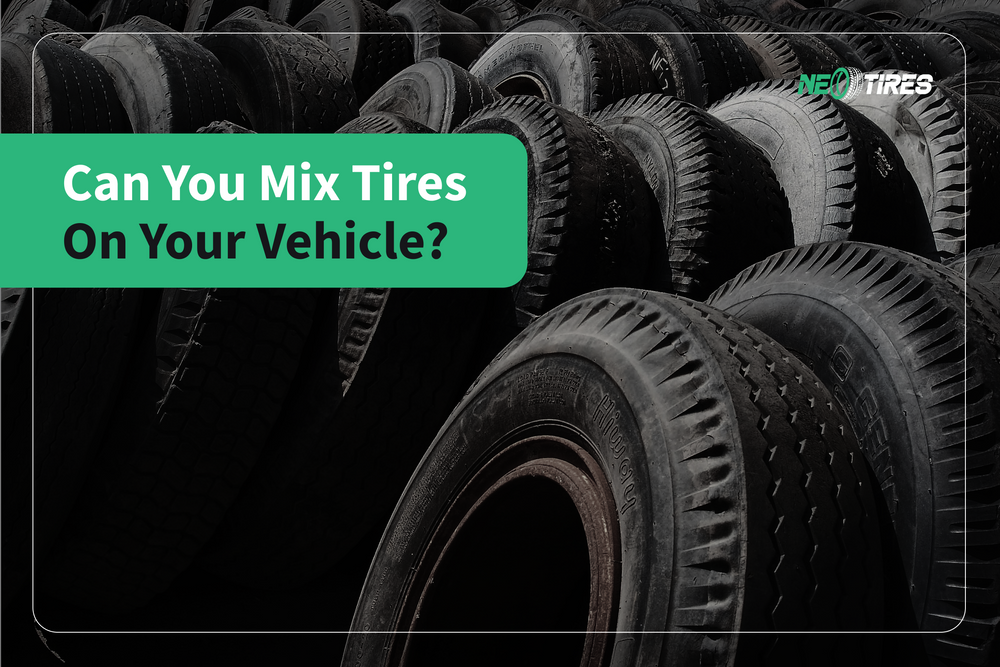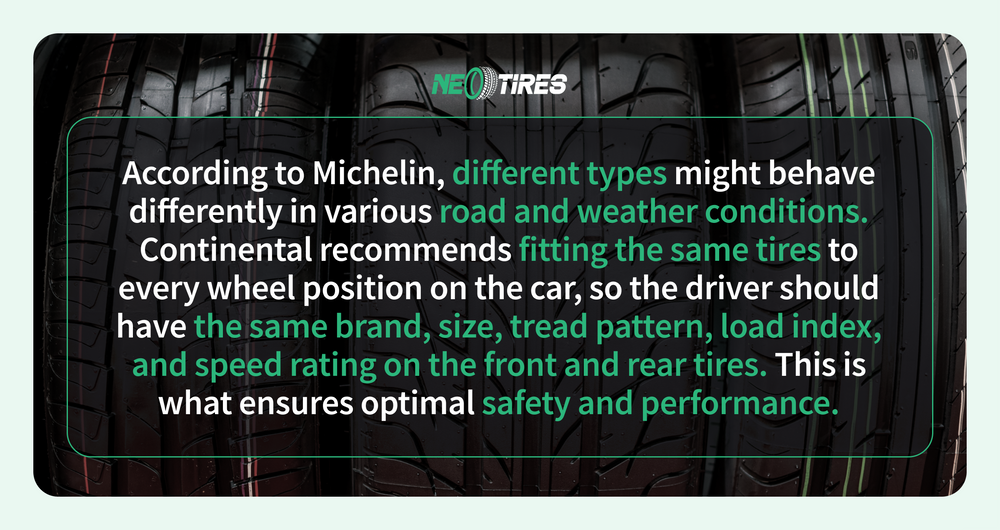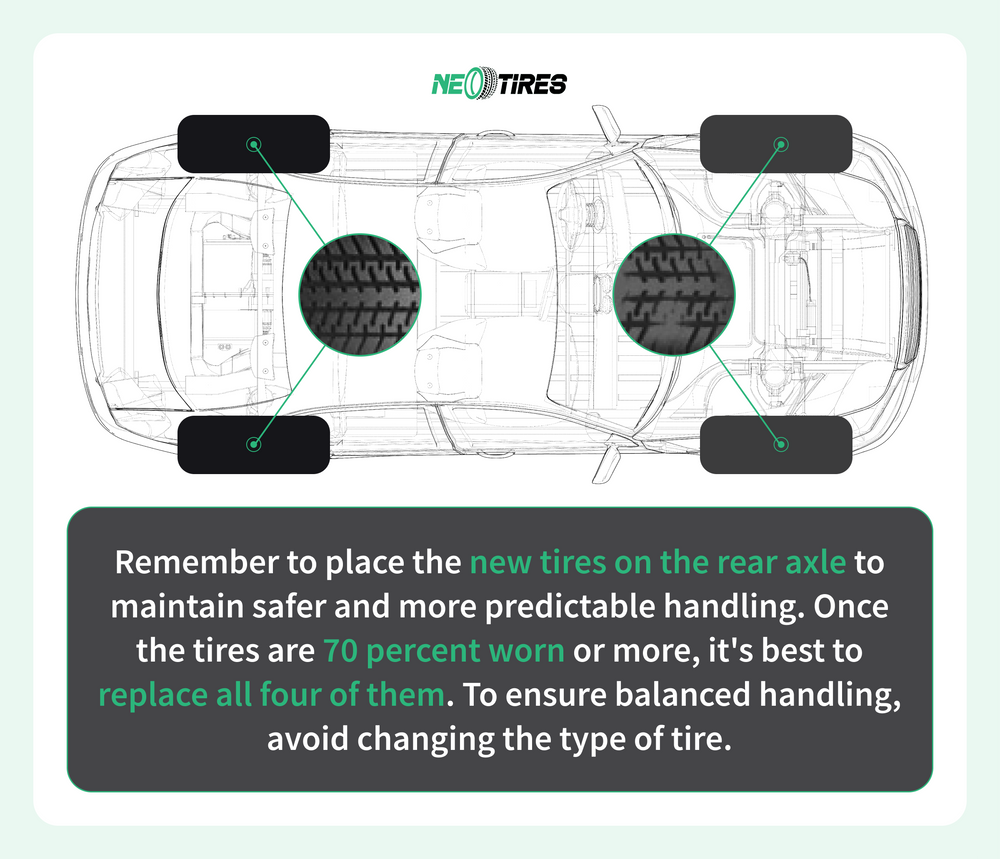Mixing tire types, brands, and specifications can affect vehicle performance and handling. The best practice to ensure safe and performant driving is to choose identical tires (same brand, tread depth, load/speed ratings) according to the manufacturer's specifications. This article compiles everything a driver should know about mixing tires. We'll explore the conditions in which this is possible and when it is unacceptable.
Can You Mix Tire Brands on the Same Vehicle?
As per Michelin, mixing tire brands on the same vehicle does not go against the law and is generally accepted. Ideally, all tires should be from the same brand. This ensures the same rubber compounds, tread patterns, and no design variations. If mixing tire brands, drivers should ensure the tires are of the same type and rating specs and feature the same design and tread depth. Also, each vehicle's axles should be mounted with tires from the same brand (one brand on the rear and another brand on the front).
Can You Mix Tire Tread Patterns on the Same Vehicle?
Mixing tire tread patterns is possible but not advisable due to possible uneven wear (if used for too long) or potential handling issues (especially on wet roads and while cornering). Michelin and Continental guidances encourage using tires with the same tread pattern across all four tires. If this is not possible, drivers should at least put tires with the same tread pattern on each of the axles to maintain performance and balance.
Can You Mix Tires With Different Load and Speed Indexes?
Mixing different speed and load indexes between tires is generally accepted whenever the ratings are higher than the minimum threshold recommended by the manufacturer. Drivers should mount tires with identical speed/load index on the same axle. Also, tires with a higher index should always go on the rear axle. For example, a vehicle typically driving on 4 H-rating tires (up to 130 MPH) can get two new V-ratng tires (up to 149 MPH). In this case, the V-rating tires should go to the rear, while the driver should consider the speed rating of those tires with a lower rating during his rides.
Can You Mix Tires With Different Tread Depths?
Mixing tires with different tread depths is usually acceptable whenever done the right way. Tires with the new/deeper tread depth should go to the rear axle for better grip and higher stability. Tires with deeper tread on the rear better mitigate the oversteering tendency, especially on wet surfaces. Check the manufacturer's specifications if owning an FWD vehicle, as new tires might be required to be mounted on the front.
Mixing Tires: FAQs
Do All Four Tires Need to Match?
The best practice to ensure safety and performance is to match all four tires in brand, tread pattern and depth, speed, and load ratings. However, it is not mandatory. What matters is that at least the tires on the same axle are identical. This means the same tread, the same depth, the same size, and the same speed/load indexes as a bare minimum.
Do You Need Identical Tires on the Same Axle?
Yes, tires need to be identical on the same axle for safety and performance reasons. This means the tread type, depth, size, speed, and load indexes should be the same on each of the axles. Different load and speed ratings, tread patterns, and tread depth are permissible only between axles when matching four tires is not possible. In such cases, tires with higher load/speed indexes are mounted on the rear axle.
| Mixing Tires | Acceptable/Not Recommended | Recommendation/ Reason |
| Mixing tire brands | Acceptable | Each axle should have same-brand tires; different-brand tires should have the same design, depth, type |
| Mixing tire tread patterns | Acceptable | A pair of identical tires should be installed on the rear axle, or a pair of identical tires to the front |
| Mixing tire load/speed indexes | Acceptable | Only if the load/speed indexes are higher than the minimum recommended threshold. Tires with higher speed/load index should go to the rear |
| Mixing tire tread depth | Acceptable | New/deeper tread should go to the rear, unless (the FWD manufacturer recommends otherwise) |
| Mixing tires on the front and rear axle | Acceptable | Install deeper tread tires at the rear for better handling |
| Mixing tires on 4x4 vehicles | Not recommended | Potential for differential disruption. Always consult a professional |
| Mixing winter & summer tires | Not recommended | Because of tire performance conflict, risks of overseer, and differing handling characteristics |
| Mixing different tire types on the same axle | Not recommended | Generally prohibited due to potential instability and malfunctions in the vehicle’s systems (like ESP) |
Find the Perfect Tire Fit with NeoTires
Tire mismatches can affect performance and safety. To ensure an optimal driving experience, make sure all four tires are appropriately matched.
Explore the NeoTires catalog if you are considering a replacement! You will find the best products at affordable prices for a smooth and safe drive.
Questions about what tires suit you best? Reach our trained assistants for personalized guidance! Drive safe and choose your tires wisely!
Why Trust NeoTires?
Tires have been our object of study for more than 5 years. We are passionate about this science and especially about the technologies that transform tires into attributes that greatly influence the performance of vehicles in various conditions. Thus, we have come to know this industry well and can help you find the right tires for your specific needs.
You are always welcome to seek expert tips and informational support to improve your driving experience. While we cannot change the conditions under which you drive, let us help you find the right tires for your vehicle. You can trust our qualified assistance. Drive safe, and choose your tires wisely!






